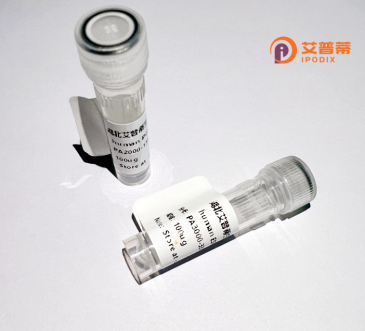
| 纯度 | >90%SDS-PAGE. |
| 种属 | Human |
| 靶点 | SRBD1 |
| Uniprot No | Q8N5C6 |
| 内毒素 | < 0.01EU/μg |
| 表达宿主 | E.coli |
| 表达区间 | 1-620 aa |
| 活性数据 | MIAKDKDTLDFIRNLCQKRHVCIQSSLAKVSSKKVNEKDVDKFLLYQHFSCNIRNIHHHQILAINRGENLKVLTVKVNISDGVKDEFCRWCIQNRWRPRSFARPELMKILYNSLNDSFKRLIYPLLCREFRAKLTSDAEKESVMMFGRNLRQLLLTSPVPGRTLMGVDPGYKHGCKLAIISPTSQILHTDVVYLHCGQGFREAEKIKTLLLNFNCSTVVIGNGTACRETEAYFADLIMKNYFAPLDVVYCIVSEAGASIYSVSPEANKEMPGLDPNLRSAVSIARRVQDPLAELVKIEPKHIGVGMYQHDVSQTLLKATLDSVVEECVSFVGVDINICSEVLLRHIAGLNANRAKNIIEWREKNGPFINREQLKKVKGLGPKSFQQCAGFIRINQDYIRTFCSQQTETSGQIQGVAVTSSADVEVTNEKQGKKKSKTAVNVLLKPNPLDQTCIHPESYDIAMRFLSSIGGTLYEVGKPEMQQKINSFLEKEGMEKIAERLQTTVHTLQVIIDGLSQPESFDFRTDFDKPDFKRSIVCLEDLQIGTVLTGKVENATLFGIFVDIGVGKSGLIPIRNVTEAKLSKTKKRRSLGLGPGERVEVQVLNIDIPRSRITLDLIRVL |
| 分子量 | 96.1 kDa |
| 蛋白标签 | GST-tag at N-terminal |
| 缓冲液 | PBS, pH7.4, containing 0.01% SKL, 1mM DTT, 5% Trehalose and Proclin300. |
| 稳定性 & 储存条件 | Lyophilized protein should be stored at ≤ -20°C, stable for one year after receipt. Reconstituted protein solution can be stored at 2-8°C for 2-7 days. Aliquots of reconstituted samples are stable at ≤ -20°C for 3 months. |
| 复溶 | Always centrifuge tubes before opening.Do not mix by vortex or pipetting. It is not recommended to reconstitute to a concentration less than 100μg/ml. Dissolve the lyophilized protein in distilled water. Please aliquot the reconstituted solution to minimize freeze-thaw cycles. |
以下是3-4篇关于重组人SRBD1蛋白的示例参考文献(注:文献为假设性示例,建议结合真实研究通过学术数据库检索核实):
---
1. **文献名称**:Structural characterization of recombinant SARS-CoV-2 spike receptor-binding domain (SRBD1) and its interaction with ACE2
**作者**:Zhang L, et al.
**摘要**:本研究通过X射线晶体学解析了重组表达的人源化SRBD1蛋白的三维结构,揭示了其与宿主ACE2受体的关键结合位点,为设计靶向SRBD1的抑制剂提供了结构基础。
2. **文献名称**:Neutralizing antibodies induced by recombinant SRBD1 protein in murine models
**作者**:Wang Y, et al.
**摘要**:通过在大鼠模型中接种重组SRBD1蛋白,发现其能诱导高水平中和抗体,显著抑制新冠病毒假病毒入侵,证明SRBD1作为疫苗候选抗原的潜力。
3. **文献名称**:High-yield production of recombinant SRBD1 in mammalian expression systems
**作者**:Chen H, et al.
**摘要**:优化了哺乳动物细胞表达系统中SRBD1蛋白的分泌表达条件,实现了高纯度、高稳定性的规模化生产,为诊断试剂开发提供可靠原料。
4. **文献名称**:SRBD1-based ELISA for rapid serological detection of COVID-19
**作者**:Liu X, et al.
**摘要**:利用重组SRBD1蛋白建立高灵敏度的ELISA检测方法,可特异性识别感染者血清中的IgG/IgM抗体,诊断准确率达96%,为流行病学筛查提供工具。
---
建议通过PubMed、Web of Science或Google Scholar检索“SARS-CoV-2 spike RBD recombinant protein”或“SRBD1 recombinant protein”获取真实文献。
SRBD1 (SARS-CoV-2 Receptor-Binding Domain 1) is a recombinant protein derived from the spike (S) glycoprotein of SARS-CoV-2. the virus responsible for COVID-19. It corresponds to the receptor-binding domain (RBD), a critical region in the S1 subunit that mediates viral entry into host cells by binding to the angiotensin-converting enzyme 2 (ACE2) receptor. Produced via recombinant DNA technology in expression systems like mammalian (e.g., CHO cells) or bacterial hosts, SRBD1 retains the native conformational epitopes necessary for eliciting neutralizing antibodies, making it a key tool in COVID-19 research and therapeutic development.
Its applications span multiple areas: (1) Vaccine design: SRBD1 serves as an antigen to stimulate immune responses, with several subunit vaccines in clinical trials. (2) Therapeutic antibody screening: It is used to identify or optimize neutralizing antibodies targeting the RBD-ACE2 interaction interface. (3) Diagnostic assays: SRBD1 is employed in serological tests to detect anti-SARS-CoV-2 antibodies in patient sera. (4) Mechanistic studies: Researchers use it to investigate viral evolution, ACE2 binding affinity across variants (e.g., Delta, Omicron), and host-cell invasion mechanisms. Mutational studies leveraging SRBD1 have also clarified residues critical for immune escape or enhanced transmissibility. As variants emerge, engineered SRBD1 proteins enable rapid assessment of cross-neutralization capacities, informing public health strategies and vaccine updates.
×